Chapter 8. The maize people in the Mesoamerican dry corridor Milpa food system of the Maya Ch’orti’ people in Chiquimula, Guatemala
Section 1 Community and food system profile
1. GEOGRAPHIC CONTEXT
This study was conducted in the Department of Chiquimula, Guatemala with six Maya Ch’orti’ communities situated in three municipalities – Camotán, Jocotán and Olopa (Figure 8.1). The Department of Chiquimula falls within the dry corridor of Central America. The vegetation in the study area is a mix of tropical temperate rainforest (100 percent of Olopa), subtropical humid forest (75 percent of Camotán and 80 percent of Jocotán), subtropical dry forest (15 percent of Jocotán and 25 percent of Camotán), and subtropical thorn bush (5 percent of Jocotán). Rainfall in the tropical temperate rainforest zones is around 1 300 mm annually with temperatures around 15 °C. The subtropical humid forest zones receive between 1 100 mm and 1 350 mm precipitation annually and have temperatures ranging between 20 °C and 26 °C. Areas of subtropical dry forest receive much less rainfall, from 500 mm to 855 mm annually, with temperatures ranging from 19 °C to 34 °C. The subtropical thorn bush has annual rainfall of 400 mm to 600 mm and temperatures ranging from 24 °C to 36 °C.

The topography of Chiquimula is rugged, consisting of a combination of hills and mountains sloping steeply down into river valleys. Despite frequently experiencing drought conditions, the Ch’orti’ region is considered to have abundant water resources. The municipality of Jocotán has five rivers and 30 tributaries, the most important being the Rio Grande. The participating communities were situated in different altitudinal zones ranging from the lowlands situated below 760 metres above sea level (masl) to the highlands located above 1 200 masl: Caserío Pitahaya, Nearar (hereon referred to as Pitahaya) at 760 masl; Caserío Chagüitón, Dos Quebradas (hereon referred to as Chagüitón) at 815 masl; Caserío Chantiago, El Rodeo (hereon referred to as Chantiago) at 880 masl; Caserío Chatuncito, Tunucó Arriba (hereon referred to as Chatuncito) at 1 000 masl; Caserío La Ceiba, Tunucó Arriba (hereon referred to as La Ceiba) at 1 050 masl; and Agua Blanca at 1 550 masl.
2. LOCAL DEMOGRAPHICS AND SOCIAL ORGANIZATION
At present, the Ch’orti’ population of Guatemala is based almost entirely in the Department of Chiquimula spanning across the municipalities of Jocotán, Camotán, Olopa, San Juan Hermitage and Quetzaltepeque. Of the municipalities participating in the study, Jocotán is the most populous (69 519 people; 80 percent Ch’orti’), followed by Camotán (51 940 people; 60 percent Ch’orti’) and Olopa (28 268 people; 65 percent Ch’orti’). Ch’orti’ populations tend to live in rural areas, whilst the urban centres are dominated by Ladino populations. The dominant language in the Ch’orti’ region is Spanish, whilst the Ch’orti’ ancestral languages, such as Ch’orti’ or Apay, are spoken almost exclusively in remote villages and homesteads. The religion in Ch’orti’ villages is mostly Catholic, though many continue to practise ceremonies of their traditional Maya cosmovision regardless of religious affiliations.
A typical Ch’orti’ household consists of a couple, man and wife, and their dependent children who live together in one house and commonly as part of a cooperating multi-household unit where each family is entitled to an equal share of their ancestral land. Whilst there are economic and social differences amongst individuals and households, the Ch’orti’ communities do not have a distinct social class system. Social standing is primarily based on merit; therefore highly skilled artisans and those with special knowledge, such as healers and midwives, are respected members of society. The highest authority of each community is the President of the Consejos Comunitarios de Desarrollo Rural (COCODES) or the elected auxiliary mayor who represents the community to the municipality.
3. LOCAL FOOD PRODUCTION
The Ch’orti’ call themselves a campesino pueblo who have been dedicated for millennia to agricultural production of the basic foods in the diet, primarily maíz (Zea mays, maize), frijoles (Phaseolus vulgaris, beans) and squashes (Cucurbita spp.). The main ways in which the community generates food is from the milpa, the patios (home gardens), productive live fences and maintained communal forest areas.
Crops
Ch’orti’ communities consider the milpa the most important part of the food system as it is the primary source for the staples of their diet: maize and beans. The importance of the milpa is grounded in the creation myth of the Maya, which states that humanity was created from maize. The defining characteristics of the milpa are the production of maize, beans and squashes on a cleared plot. Practices in milpa production vary within the territory from more “modern” high-input, homogeneous models to more traditional methods that integrate other production elements. Traditional techniques include the use of alley cropping with trees or shrubs such as madre de cacao (Gliricidia sepium, gliricidia), chipilín (Crotalaria longirostrata, chipilin), chatate (Cnidoscolus aconitifoliustree, spinach) and izote (Yucca gigantea Lem., Asparagaceae) to encourage an understory of wild edible and medicinal plants, as well as interplanting with a variety of species such as güisquil (Sechium edule, chayote), palo de pito (Erythrina berteroana), muta (Bromelia spp.), piña (Ananas comosus, pineapple), a variety of chilies (Capsicum sp.), sandia (Citrullus lanatus, watermelon) and camote (Ipomoea batatas, sweet potato). Productive living fences are composed of multipurpose trees, bushes and thorny plants (Bromelia spp. and/or Agavaceae spp.) that provide a barrier to delineate between milpas and households, whilst also including species with food uses.
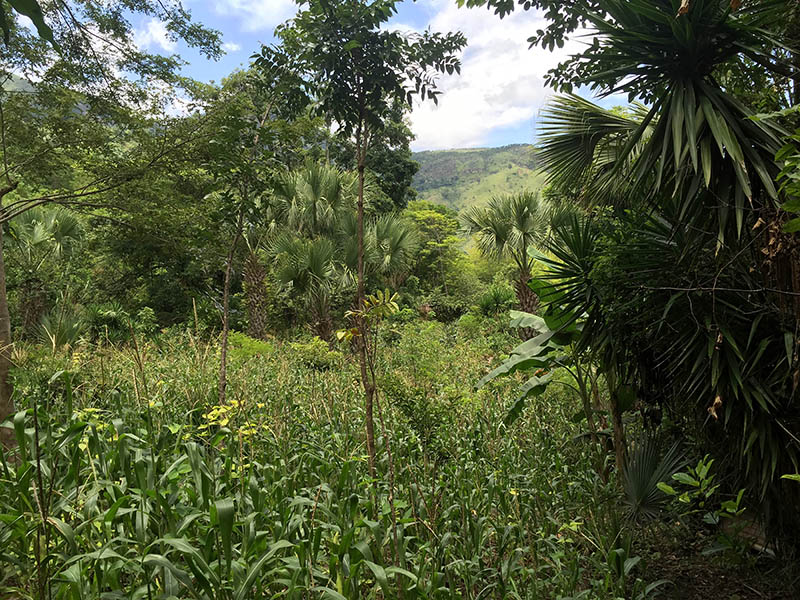
© Universidad del Valle de Guatemala/Silvana Maselli.
Analogous to a home garden, the patios are located in close proximity to the home and vary in size depending on the availability of land and number of family members. Patios tend to have four levels of production. The first level includes tubers and underground bulbs such as malanga (Xanthosoma sagittifolium, arrowleaf elephant ear), sweet potato and chayote. The second level consists of low plants, including bush beans, garbanzo (Cicer arietinum, chickpea), hierba mora (Solanum americanum and Solanum nigrescens, black nightshade), bledo (Amaranthus viridis, slender amaranth), tomato (Solanum lycopersicum), chilies, herbs, and small milpas from which fresh ears of maize may be eaten. The third level includes shrubs and medium-sized trees such as café (Coffea spp., coffee), tree spinach, chipilin, higos (Ficus carica, fig), anona (Annona reticulata, custard-apple), citrus fruits (Citrus sp.), papaya (Carica papaya), guava (Psidium guajava) and cacao (Theobroma cacao). The fourth level includes high canopy trees such as zapote (Pouteria sapota), sunza (Licania platypus), tamarind (Tamarindus indica), conacaste (Enterolobium cyclocarpum (Jacq.) Griseb., Fabaceae), teak (Tectona grandis L.f., Lamiaceae), ceiba (Ceiba sp., Malvaceae) and roof palms (Attalea cohune Mart., Arecaceae).



Livestock
In productive patios, families keep several domestic animals, such as gallina (Gallus gallus domesticus, chicken), pato and pato criollo (Anas platyrhynchos; Cairina moschata, ducks) and pijije (Dendrocygna autumnalis, black-bellied whistling-duck), chompipe (Meleagris gallopavo, turkey) and cerdo (Sus scrofa domesticus, pig), as well as hives of meliponas (Melipona spp., stingless honeybees). Bee swarms are collected in the landscape to keep in the patio or even in the house. In rare cases, families may have one or more ruminant such as cows (Bos taurus), goats (Capra hircus aegagrus) or sheep (Ovis aries). The meat obtained from domestic animals is mostly consumed fresh with the exception of pig lard and some that is salted and dried in the sun. Pig blood is sometimes collected during slaughter then boiled with cebolla (Allium cepa, onions), ajo (Allium sativum, garlic) and other spices and encased in the intestines like sausage. Animals are free to forage in the patios and are mostly fed household food scraps. Households also gather available leaves and grasses for forage from live fences, patios and communal lands next to roads, especially of moringa (Moringa oleifera), madre de cacao, tree spinach, malanga, Mexican sunflower (Tithonia diversifolia (Hemsl.) A. Gray, Asteraceae), and bejuco campanilla (Ipomoea grandifolia (Dammer) O’Donell, Convolvulaceae). Forage is complemented by fallen fruits and fresh or nixtamalized maize.
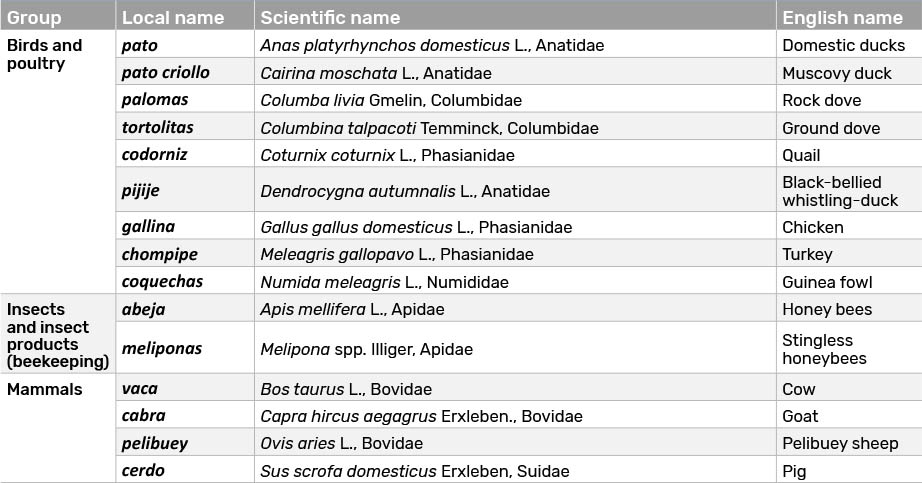
Aquaculture
Whilst it is not common practice, rarely patios will have small aquaculture systems that produce freshwater snails or fish for household consumption and trade. One household in La Marimba, a village next to Chagüitón, produces tilapia (Oreochromis niloticus) in a patio aquaculture system for sale in the community. Another aquatic production method used by a community member in their patio diverts grey water into various filtration pools at different levels to raise jute and caracol (Bithynia tentaculata; Pomacea maculate, snails), tilapia, berro de agua (Nasturtium officinale, watercress) and santa maria (Piper auritum, Mexican pepperleaf).

Wild edibles
Wild gathered plants have a vital importance to everyday life in Ch’orti’ communities. Locally gathered crops, and especially green leafy vegetables, are considered to be of superior quality and value is placed on them in markets, where they cost more than cultivated crops. Wild edibles are collected from the wild, from patios or living fences, and along the edges of walking paths and roadsides. Women specialized in wild mushroom harvesting maintain rich knowledge of the place and time when fruiting occurs. Given the perishability and quantity of mushrooms harvested at one time, they are often shared in the community or taken to the market of Jocotán. Honey is also collected from the landscape where bees have established hives.
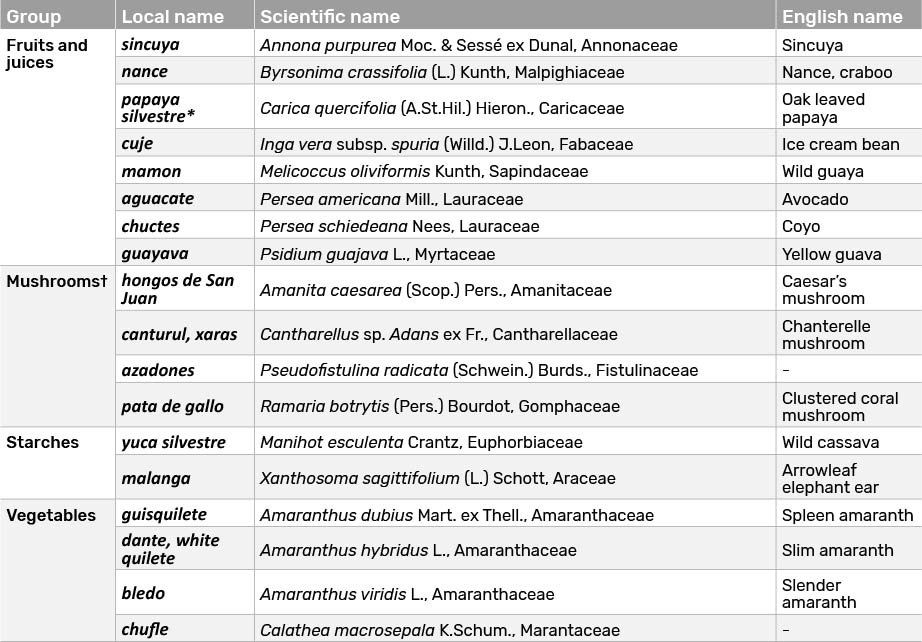

Fishing, hunting and trapping
Fishing is seldom practised in the villages but in the summer months, when the water is clear, some young people go out in groups to practise diving and fishing by hand in pools along larger rivers and tributaries. Usually the fish caught are shared amongst the members of the group to be used for family consumption. If more fish are caught than necessary, the catch is shared with neighbours who often return the favour with surplus fruit or other goods later on in the season. The Ch’orti’ are a culture specialized in hunting with blowguns, different types of traps, and poisons derived from plant, mineral and animal sources. These practices have nearly completely disappeared and persist only in isolated communities. Though hunting and trapping are now considered more of a hobby, it is still possible to buy the meat of iguanas (Iguana iguana), tacuazin (Didelphis marsupialis, opossum) and cusuco (Dasypodidae sp., armadillos) at local markets.
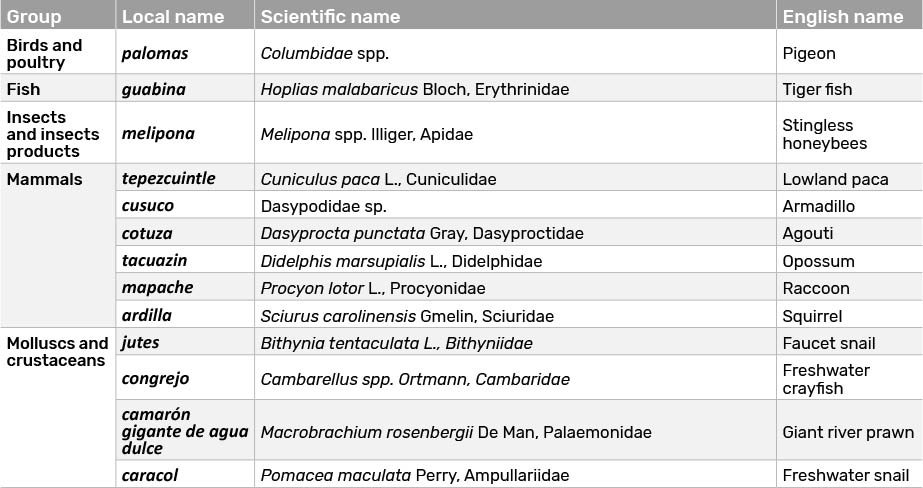

4. OTHER LAND-BASED PRODUCTIVE ACTIVITIES
Ch’orti’ families produce handicrafts from five main types of material: palm (Arecaceae spp.), maguey (Agave americana L., Asparagaceae), carrizo (Arundo donax L., Poaceae), tul (Schoenoplectus acutus (Muhl.) Á.Löve & D.Löve, Cyperaceae), and sand or clay pottery. Palm products include mats, hats, brooms, ropes, bags, fans, baskets, and covers for bottles made from the leaves and buds of palms. Fibres from maguey leaves are used to make pita (thread or yarn), with which different handicrafts are made such as hammocks, ropes, nets and bags. Carrizo is a raw material widely used by artisans in the Ch’orti’ region to make baskets of various sizes and containers for weighing basic grains. Tul is a reed from which the heart, stem and rind are used to create products such as jewelry and mats. Sand and clay are used to make pottery products for domestic use such as pots, comales (griddles) and jars.
The extraction of natural dyes is a long-held tradition in Ch’orti’ communities. Plant-based dyes include indigo (Indigofera tinctoria L., Fabaceae) and yellow (Erythrina berteroana). Clay-based dyes are red, green, dark yellow and brown. A carmine (dark red) dye is made from cochineal (Dactylopius coccus Costa, Dactylopiidae). In remote villages, all the material used for houses is sourced from living fences, patios, milpas and surrounding forests. Minerals such as adobe and bahareque (mud or earth) are used as construction materials integrated with wood such as cualote (Guazuma ulmifolia Lam., Malvaceae) and zapote beams and woven palm. Roofs are often made using roof palm, although metal roofs are becoming more common.
Medicines and poisons are obtained using different plants, animals and minerals measured in carefully determined doses. The crushed leaves from madre de cacao are used both as poison for rodents and as a remedy for botfly (Dermatobia hominis L., Oestridae). Sometimes wild toads are collected to extract bufotoxin as a medicine and to produce poisoned darts for hunting. The mineral calcium oxide is essential for nixtamalization of grains (primarily maize) to improve their digestibility and nutritional content assimilation. Now produced on an industrial scale, the home collection of calcium oxide continues by processing wood ash or stones. This compound is also widely used in the production of clay and pottery.
5. LOCAL CALENDAR
The seasonal calendar of the Ch’orti’ is deeply tied to agricultural activities throughout the year. Currently the Ch’orti’ use the Gregorian calendar and they recognise two main seasons: the rainy winter season that runs from May to November, with a dry period called the canícula from June or July until August or even early September, and a dry summer season that runs from December until April. During the year, agricultural activities of Ch’ort’i women focus on the household patios and harvesting of wild mushrooms, and men undertake most of the fieldwork.
The dry summer months are the most difficult for families of the Ch’orti’ region because much of the vegetation is desiccated and water sources can be limited if rains were insufficient. During this time, many men and young people will migrate to find sources of employment to sustain their households and earn money to purchase farm inputs for the next planting season. After the migration to neighbouring municipalities such as Camotán, Olopa, Esquipulas, Chiquimula, La Unión in Zacapa and Honduras to harvest coffee, naranja (Citrus sinensis, orange) and caña de azucar (Saccharum officinarum, sugar cane), they return in April to prepare the milpas.
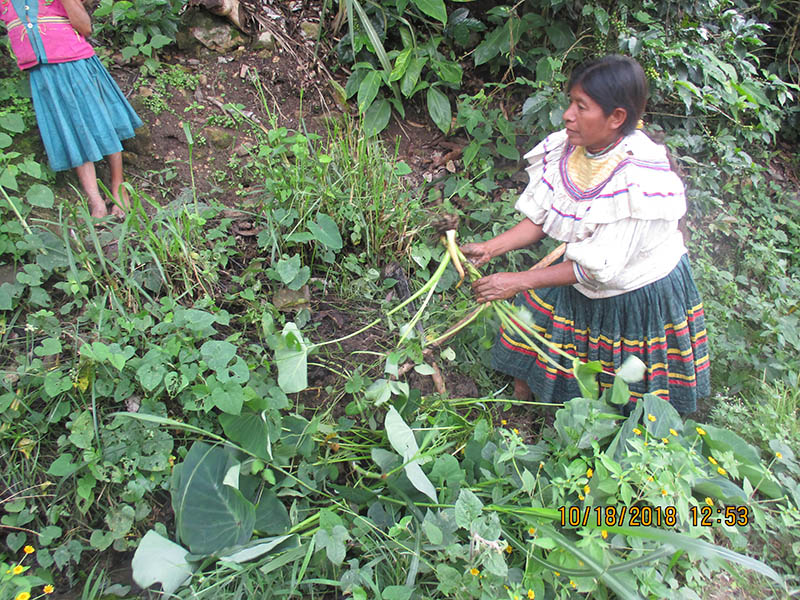
© Alliance of Bioversity International and CIAT/Carlos Lira.
The song of cicadas in March or April and the emergence of black ants from their hills in April or May are signs of the arrival of the rainy season. Cloud patterns in the skies (for example, when they occur in a woven form or settle on top of mountains and hills) also signify the coming of rains. When a “wheel” is seen around the sun, the people know that the rains will begin in three to five days. The rains typically start in April or May and are crucial for establishing annual crops. Households plan their planting cycles depending on when the initial rains fall. Most villagers wait for two heavy rainfalls so that the soil has enough moisture for the maize seed to germinate. Others follow the moon phases for planting, regardless of soil moisture.
On the third day of May, many residents hold a “De La Cruz” celebration at church to ensure a successful planting and sufficient production in the rainy season. During this time, households also perform traditional spiritual ceremonies for the same purpose that consist of feeding the earth so it has the strength to produce; they dig a hole and deposit an offering of traditional toasted maize called chilate. The first sowing of maize, beans, sorgo (Sorghum bicolor, sorghum) and squash in the milpa usually takes place at the end of April or May, but it can take place as late as June. Cooler weather and rains in the winter season stimulate growth of local spontaneous herbs. During this time, the whole family keeps busy, with men working at least four days a week to manage the milpa by cleaning, hilling, controlling insects, applying fertilizer, or weeding and helping other families as well.
With the arrival of the canícula in July and August, lowland farmers bend the maize plants in the milpa so that resuming rains cannot penetrate the husks and rot the grains. Signs indicating the end of the canícula are observed in clouds and insects. During this time, farmers harvest the beans from the first sowing and clean the land for the second sowing in the alleys of the maize furrows. Fruit trees are also planted during the canícula, as the soil has moisture and the longest period of rains will follow. In October to December, root crops like malanga, yuca (Manihot esculenta, cassava) and sweet potato can be harvested; from December to January, the second bean crop is harvested. Later varieties of dry beans are planted through November and December. The end of winter in November is signified either by a dark cloud formation known as argenia or by the song of the guaco bird (Herpetotheres cachinnans L., Falconidae).

6. MARKET SOURCING AND TRADE
Currently households purchase almost half of what is consumed in the home. The Jocotán market is the commercial centre of the food system, as it is the only market within a reasonable distance to the communities. Goods from surrounding villages are offered every day in the main square and especially on Sundays, as after mass it is customary to purchase food for the week. The Jocotán market offers a wide selection of products that come from the municipalities of Camotán, Jocotán, San Juan Ermita and Olopa, as well as from Guatemala City, Honduras and El Salvador. Two supermarkets in Jocotán – El Oasis and the Family Pantry – offer processed food products. The products fabricated with industrial processes come primarily from Guatemala City. Market-sourced food products ranked as having the highest importance to households are salt, limon persa (Citrus × latifolia, lime), maize, beans, onions, carrots, rapollo (Brassica oleracea, cabbage), oil, soap and detergent. In addition to foods, shops in Jocotán offer products for construction, tools, medicines, agroindustry, shoes, clothes, appliances and technological products.
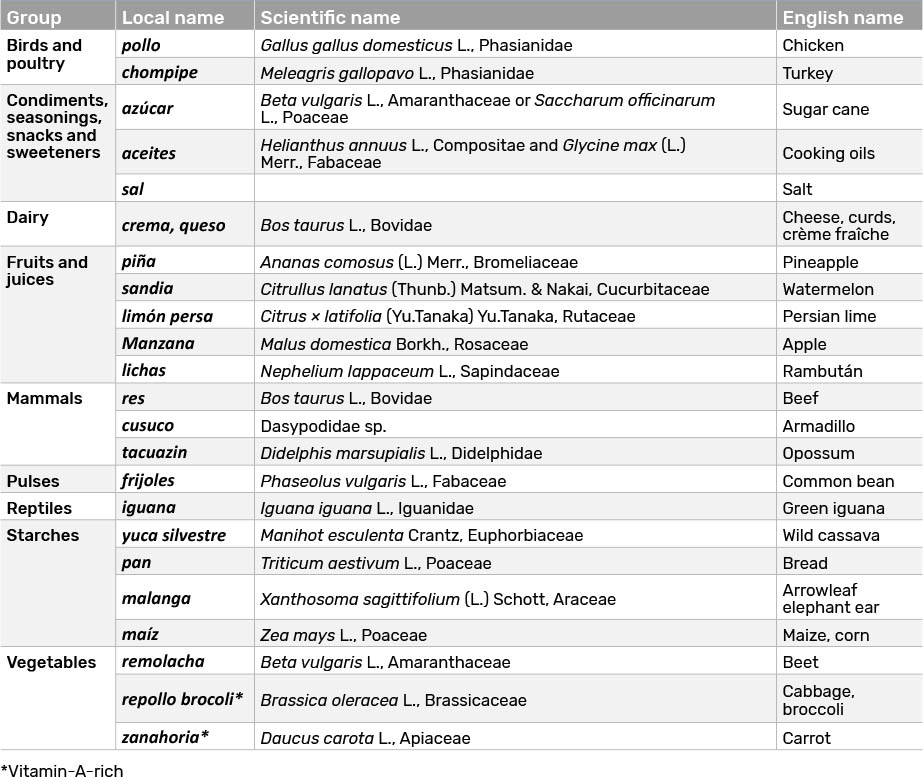
Whilst Maya Ch’orti’ communities are relatively close to the market in Jocotán, transportation costs depend on the remoteness of the village or hamlet, and physical barriers such as road quality can be prohibitive to move products and people with regularity. Self-determined travel on back roads is conducted almost exclusively by walking or taking unregulated, privately owned pickup trucks that act as an informal bus system, allowing villagers to ride in the back for a fee. The towns of Olopa, Quetzaltepeque, Esquipulas and Chiquimula also have small municipal markets but, as they are further, the transport prices increase by approximately GTQ 20–3044 round trip, making the trip less feasible. Informal trade for goods and services in the communities is common, and gifting and loans of goods and services are common practices depending on availability and need.

7. COMMUNITY HISTORY AND FOOD SYSTEM TRANSITIONS
Through interpretation of ancient artifacts such as the glyphs on stelae, vessels and inscriptions, as well as oral and written histories, it is known that the ancestral territory of the Maya was divided by its cardinal points into four large territories. The eastern territory was known as the Señorio Ch’orti’, or Señorio de Payaqui, or Chiquimulja and it had its cultural centre in the city of Copantl – the modern-day city of Copan in Honduras (Christenson, 2007). Ch’orti’ is the name that currently describes the Indigenous People of this extensive eastern territory, now divided by modern political borders and spanning three countries of Central America – Guatemala, Honduras and El Salvador. The Ch’orti’ are closely related to the lowland Maya (in the Yucatán Peninsula and Belize) and considered united under the Classic Maya culture (Metz, McNeil and Hull, 2009).
It is hypothesized that prior to colonization, Ch’orti’ populations had started farming at higher elevations in the mountains to increase production (Metz, McNeil and Hull, 2009; Sanders and Murdy, 1982; Veblen, 1982). The Señorío Ch’orti’ was formidable in resisting the Spanish until around 1530, when the Spanish conquest of Copantl broke the territorial alliance and placed colonists in positions of power. The Spanish system forced local populations to become labourers, sharecroppers or indentured servants, or to flee into the mountains (Girard, 1949; Terga Citrón, 1980). The Ch’orti’ were heavily taxed and received lower wages than mestizos and creoles (Melchor Toledo, 2011). Despite colonialization, the Ch’orti’ people remained organised as evidenced by their ability to purchase back 635 cavalries (70 000 hectares) of their seized territory from the King of Spain (Mendoza Lopez, 2017).
The court of Cadiz in Spain suspended all taxation on Indigenous Peoples in 1820, releasing Ch’orti’ people from imposed obligations. In 1821, Guatemala became independent from Spain and by 1825 in present day Izabal, the Louisiana Treaty divided the Ch’orti’ ancestral territory across the borders of Guatemala, Honduras and El Salvador. In 1837, an attempt was made to restore taxes to the Indigenous Peoples that was rejected by Rafael Carrera and his supporters, leading to a revolution with broad support from the Mayan peoples, including the Ch’orti’. Carrera, who was half indigenous and half mestizo, established protective measures for indigenous territory with the foundation of the Republic of Guatemala on 21 March 1847 and he governed until his death in 1865. There was political chaos for the next five years until 1871, when the liberals led by Justo Rufino Barrios and Miguel García Granados came into political power. This period brought the development of large industry and primarily agricultural exports, leading to seizure of communal and rented lands for large-scale production of coffee, tobacco, sugar, rice, maize and fibres (Dary, Elias and Reyna, 1998).
Despite continuing political shifts, following the death of Barrios in 1885, the Ch’orti’ supported and maintained a robust local economy with knowledge and values of their culture, as evidenced by the writings of Charles Wisdom in The Ch’orti’ Indians of Guatemala (1940). Despite facing many challenges, Wisdom recounts that in 1930, the Ch’orti’ were almost completely self-sufficient and religiously independent. A testament to the resilience and economic value of the Ch’orti’ is demonstrated by Wisdom’s observation that although the Government of Guatemala had retired the silver peso in favour of the paper quetzal in 1925, it was not accepted by the Ch’orti’ and the government continued to allow a duel currency through 1933 because of their need to trade and their productive power (Wisdom, 1940, pp. 33-34).
Soon after, in 1931, the brutal 13-year military regime of Jorge Ubico began. The years under Ubico were a dark period for the Ch’orti’, forcing them to retreat to the mountains and avoid urban centres (Girard, 1949). The end of the Ubico regime was followed by a time of peace under Juan Jose Arevalo, which continued under Jacobo Arbenz (1944-1954). Both leaders supported land reform, labour standards, social services and local democracy, challenging the unequal land distribution particularly of corporations based in the United States of America (Woodward, 1993). It was the issue of land reform that sparked a coup supported by the United States of America, which overthrew Arbenz and led to lengthy civil war from 1960 to 1996, affecting indigenous populations all over the country.
The end of the civil war in the 1990s brought shifts in industry that impacted local landscapes, for example, increasing coffee production, which replaced sugar cane and panela (unrefined cane sugar) production in the temperate zones. To recognise the voice of indigenous populations and increase community representation in development, the COCODES were initiated in the early 2000s as a form of governance. The COCODES have been instrumental in improving roads to allow for increased traffic. It was only around 2014 that electricity reached the more remote villages in the study. A court case in 2016 returned the aforementioned 70 000 hectares purchased during Spanish rule, proving that they were indeed property of the Ch’orti’ (Mendoza Lopez, 2017).
In recent years, the Ch’orti’ food system has experienced several disturbances, observed as changes in seasonal patterns and increasing shocks. Since 2000, the community experienced change in the climate, noting large storms outside of the typical rainy seasons and an increase in instances of drought or prolonged dry canículas. These conditions are detrimental to staple crop production and have created a partial or in some cases complete loss of the crop of maize and beans in 2010, 2015, 2016 and 2018. Of the observed changes, the most noticeable is the shift of the winter period, which is associated with the first rains. Usually beginning in May, the shifting of these crucial rains into June also moves the first sowing of staple crops to the end of May or June and the second sowing to the end of September.
- 44 Equivalent to USD 2.6-3.9. Applying the UN Operational Rate of Exchange of 1 October 2018 (1 USD = 7.70245 GTQ). This rate will apply throughout the entire chapter.
“If we want to maintain our customs and traditions, we need to teach our children all our knowledge, so that the new generation does not lose the community values of customs and traditions and our language. If we do not teach them little by little, all the good of our times will be lost and forgotten.”
Reflections by community members during the thematic discussions
